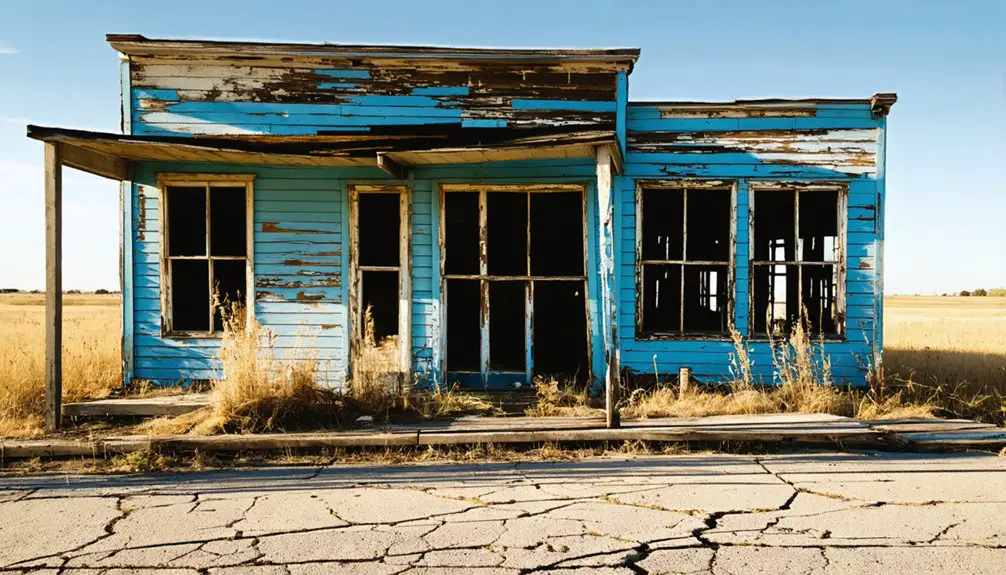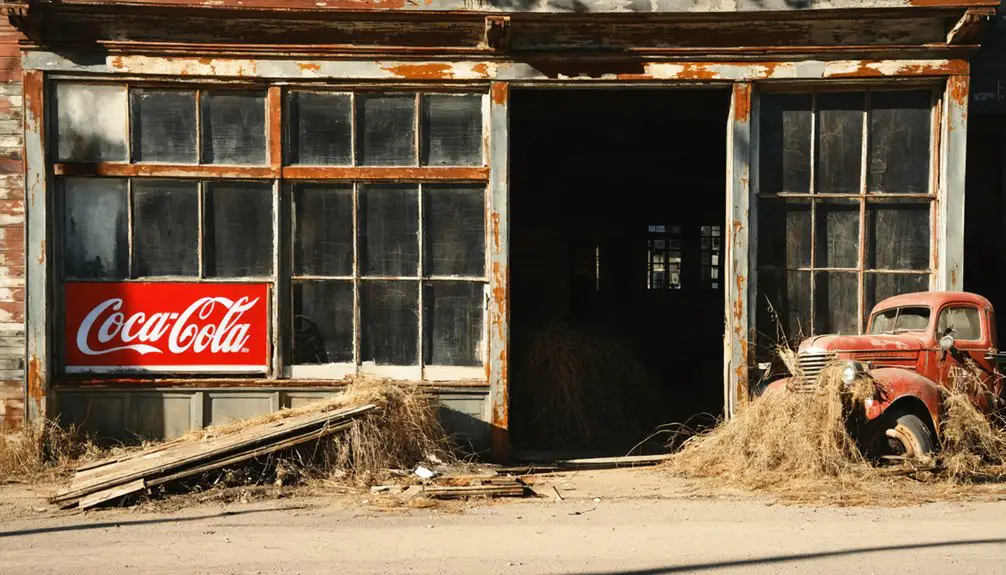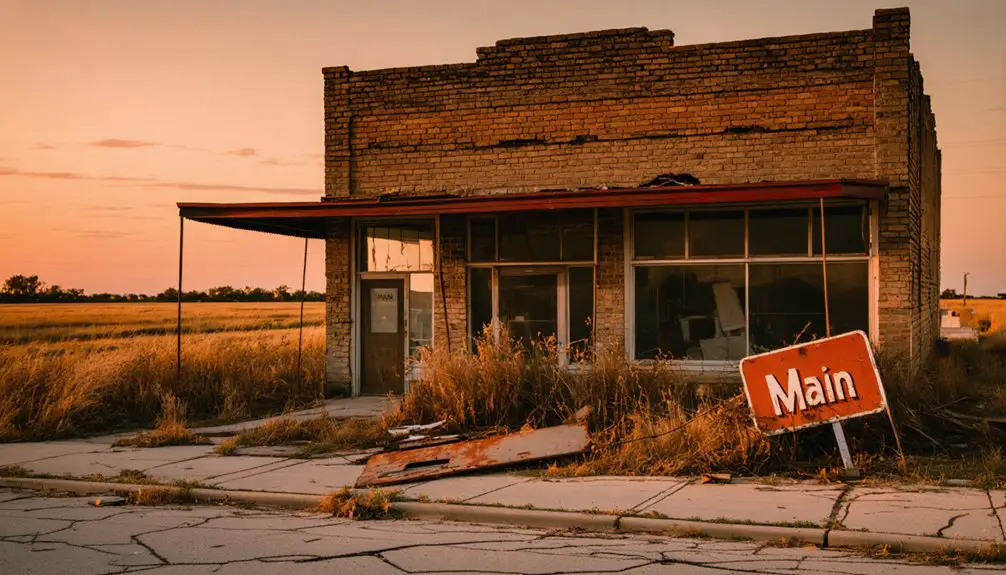You’ll find Woodford’s ghost town remains 11 miles north of Ardmore, Oklahoma, where crumbling foundations and weathered structures tell the story of a once-bustling frontier community. The town thrived on agriculture and transportation routes until the Great Depression, declining further after a devastating 1947 tornado. Today, you can explore the historic covered spring site, abandoned buildings, and limestone canyons while uncovering fascinating local legends of outlaws and hidden treasures.
Key Takeaways
- Woodford was a thriving agricultural community in Carter County, Oklahoma that declined dramatically, losing over 80% of its population.
- Located 11 miles north of Ardmore, Woodford’s strategic position near railways and trade routes initially fueled its growth.
- A devastating tornado in 1947, along with post-WWI agricultural depression and transportation shifts, contributed to the town’s abandonment.
- The town experienced brief revitalization during a 1956 oil boom but ultimately couldn’t sustain its population and economic activities.
- Today, Woodford’s remains include crumbling foundations, weathered Main Street structures, and a historically significant covered spring site.
Location and Geography of Woodford
Tucked away in Carter County, Oklahoma, Woodford sits approximately 11 miles north of Ardmore and one mile north of State Highway 53.
You’ll find this ghost town nestled in the Osage Plains region, where rolling prairies and distinctive geological features shape the landscape. It’s positioned about seven miles west of Interstate 35, making it historically accessible yet pleasantly removed from major traffic. Located west of I-35, this area was once prime territory for early oil exploration.
The area’s hydrological context includes a network of tributaries that feed into the North and South Canadian Rivers. The Cimarron River runs through similar terrain, shaping the regional watershed.
You’re in a region where natural springs dot the terrain, and the land’s unique drainage patterns have shaped local water resources.
Natural springs emerge across this rugged landscape, where centuries of water flow have carved distinctive patterns into the earth.
The surrounding geography showcases the shift between northern plains and southern agricultural zones, with gypsum deposits and salt plains characterizing the broader area’s geological makeup.
Historical Rise and Fall
You’ll find Woodford’s early settlement followed common patterns of Oklahoma territorial expansion, with the town emerging as railroads and agriculture drove development in the late 19th and early 20th centuries.
The community thrived modestly through its agricultural base and strategic location near transportation routes, supporting basic businesses and infrastructure during its peak years. Like many mining boomtowns across Oklahoma, Woodford experienced rapid growth followed by an equally swift decline when natural resources were depleted. The town’s fate mirrored the estimated two thousand ghost towns scattered across Oklahoma’s landscape.
Your understanding of Woodford’s decline parallels many Oklahoma ghost towns, as economic shifts and changing transportation patterns led to an exodus exceeding 80% of its population, leaving behind abandoned structures that tell the story of its past.
Early Settlement Patterns
Three major forces shaped Woodford’s early settlement patterns in the late 19th century: the 1893 Cherokee Outlet opening, the expansion of regional railways, and the establishment of vital transportation routes.
You’ll find that Woodford emerged during a transformative period when Plains tribal lands opened to non-Indian settlers, creating new opportunities for homesteaders and merchants alike.
The town’s strategic location near SH 53 and I-35 attracted early settlers who recognized its potential as a service point. Community institutions quickly followed, with schools, churches, and general stores springing up to meet residents’ needs.
The Southern Kansas Railway’s presence strengthened the town’s connections to regional trade networks, while local ranching and farming activities supported the growing population. Similar to the Acme Cement Company that established operations near Rush Springs, Woodford’s development relied heavily on industrial enterprise to sustain its growth.
Like many frontier communities, Woodford’s development reflected the blend of agricultural enterprise and transportation-based commerce. The area became a thriving hub for cattle shipping operations, contributing significantly to Oklahoma Territory’s livestock industry.
Economic Decline Factors
While the early settlers of Woodford built a promising community around agriculture and transportation networks, several economic factors converged to spark the town’s gradual decline.
You’ll find that post-WWI agricultural depression hit the region hard, severely reducing farm income and forcing economic adaptation from diverse crops to wheat-only farming. The Great Depression then delivered another devastating blow to the community’s resilience. The establishment of the Great Plains Field Station in 1913 attempted to support struggling farmers through agricultural research. The town’s original wild atmosphere with numerous saloons and brothels gave way to more regulated development as the frontier era ended.
Though the 1956 oil boom briefly revitalized the area after the McCormick #1 gas well discovery, this prosperity proved temporary.
Changes in transportation routes dealt the final blow – as automobiles became common and railroad relevance diminished, commerce shifted to larger towns like Woodward.
The devastating 1947 tornado further crippled the town’s chances of recovery, leading to permanent population loss.
Architectural Remnants and Ruins
Although Woodford once bustled with wooden storefronts and public buildings typical of early Oklahoma boomtowns, today’s visitors will find only deteriorating remnants scattered across the landscape.
You’ll notice architectural styles ranging from simple wood-frame structures to more substantial WPA-era brick and stone buildings, though most have succumbed to decades of abandonment. Like the nearby Works Progress Administration school buildings, these structures were built to provide jobs during the Great Depression.
The most visible ruins include crumbling foundations of former schools, partial walls of commercial buildings, and weathered remnants of Main Street storefronts. Following the devastating 1939 tornado that struck the region, many structures were never rebuilt.
Preservation challenges are evident throughout the site, where Oklahoma’s harsh climate continues to take its toll on exposed wooden beams and deteriorating masonry.
Stone foundations and brick chimneys remain the most enduring features, offering glimpses into the town’s former layout and the building techniques of early settlers.
Natural Features and Landscape
You’ll find breathtaking views of the Arbuckle Mountains rising above the surrounding plains as you explore Woodford’s natural landscape.
The historic covered spring site, once an essential water source for the community, stands as a symbol of the town’s relationship with the land. Local families still gather at this spring, sharing stories of how their ancestors relied on its pure waters while admiring the rugged terrain that has remained largely unchanged since the town’s early days.
Scenic Arbuckle Mountain Views
Nestled within the heart of Oklahoma, the Arbuckle Mountains showcase some of America’s oldest geological wonders, with rock formations dating back 1.3 billion years.
From scenic overlooks, you’ll witness rolling hills carved by millennia of erosion, where ancient peaks once towered 500 feet above the plains. Along mountain trails, you’ll discover dramatic v-shaped gorges and limestone canyons plunging 350 feet deep.
You’ll find yourself at the crossroads of two distinct worlds, where eastern woodlands meet Great Plains prairie.
The rugged landscape features vertical rock layers exposed by time, while Turner Falls cascades 77 feet down crystalline cliffs.
From Bromide Hill, you can survey Rock Creek’s winding path through the weathered terrain, offering a proof of nature’s patient sculptural work.
Historic Covered Spring Site
While the Arbuckle Mountains tell an ancient geological story, the historic covered spring at Woodford reveals a more recent tale of human survival and settlement.
You’ll find this natural groundwater emergence site nestled in fractured limestone, where indigenous tribes once gathered and pioneer settlers depended on its life-giving waters.
The spring’s unique ecology creates a microhabitat where moisture-loving plants thrive alongside the prairie landscape. Its historical significance runs deep – from sacred ceremonies to frontier water source.
Today, the protective shelter structure still guards the spring’s cool, mineral-rich waters that continue feeding shallow pools and sustaining local wildlife.
Though the ghost town stands quiet, the spring remains a monument to nature’s persistence and humanity’s connection to these crucial water sources in Oklahoma’s rugged landscape.
Local Legends and Stories

Since its abandonment, Woodford has become steeped in fascinating local legends that interweave tales of outlaw treasures, paranormal activities, and unexplained phenomena.
Legends of hidden riches and ghostly mysteries linger in Woodford’s ruins, beckoning those who seek answers to the unexplained.
You’ll find treasure myths about Jesse James’ gang and their hidden gold caches, protected by mysterious iron doors and underground tunnels throughout the area.
Like many of Oklahoma’s 2,000 ghost towns, Woodford’s abandoned structures have sparked numerous paranormal sightings and unexplained events:
- Ghostly apparitions wandering near derelict buildings and old cemeteries
- Inexplicable orbs of light and eerie sounds in the darkness
- Strange gravitational anomalies and magnetic forces that defy explanation
These stories are more than just tales – they’re part of the rich cultural fabric that keeps Woodford’s memory alive, connecting you to the town’s mysterious past and the broader supernatural lore of southwestern Oklahoma.
Preserving Woodford’s Legacy
Beyond the ghost stories and legends, Woodford’s true legacy lives on through dedicated preservation efforts across multiple fronts.
You’ll find local community engagement driving grassroots initiatives to protect the town’s remaining structures and historical sites from development pressures. The University of Oklahoma’s Western History Collection maintains essential records of Woodford’s past, while digital documentation projects guarantee these stories reach wider audiences.
Various preservation strategies work together to safeguard Woodford’s heritage.
You can explore the town’s history through museum exhibits featuring original artifacts and documents, or join virtual communities sharing memories and photographs. Local landowners play a significant role too, providing incremental protection for historically important areas.
Through these combined efforts, you’re witnessing how Woodford’s story continues to educate and inspire future generations.
Visiting the Ghost Town Today

Today you’ll find Woodford nestled in Carter County’s rural countryside, approximately 11.6 miles north and 9 miles west of Ardmore near the Arbuckle Mountains.
Your ghost town visitor experience will be most rewarding during fall or spring when the weather’s mild. While 2WD vehicles can access the site, prepare for variable road conditions and bring necessities as no services exist in town.
Visit during mild autumn or spring seasons and come prepared – this remote site offers no amenities for travelers.
- Explore the historic water well with its protective shelter, one of the few maintained structures
- Take in breathtaking views of the Arbuckle Mountains and crystal-clear Mountain Lake
- Travel the legendary old whisky trail that once served as a crucial trade route
The remaining residential structures and rebuilt well offer glimpses into pioneer life, making Woodford an ideal destination for those seeking to experience Oklahoma’s untamed history firsthand.
Regional Historical Context
While exploring Woodford’s remnants offers a window into pioneer life, the area’s rich history stretches back thousands of years before the town’s establishment.
You’ll find yourself standing on land where Plains tribes like the Comanche, Kiowa, Cheyenne, and Arapaho once roamed freely, hunting buffalo and trading along ancient paths. The cultural heritage of this region runs deep, with archaeological evidence revealing human presence dating back 14,000 years, including Folsom-era hunters and Plains Village farmers.
Carter County’s position as a historical crossroads makes Woodford’s story part of a larger tapestry of Indigenous history and settler expansion.
From early Spanish expeditions to the eventual establishment of ranches and farms, you’re witnessing layers of human experience that shaped Oklahoma’s distinctive character.
Photography and Exploration Tips

If you’re planning to photograph Woodford’s haunting remains, having the right equipment and techniques will make all the difference in capturing its essence. Your exploration will yield better results with a sturdy tripod and versatile lens selection, from wide-angle for sweeping views to macro for intricate details.
- Arrive early or stay late to catch dramatic lighting conditions – golden hour adds depth to weathered buildings.
- Bring safety gear and let others know your plans, as structures can be unstable.
- Use manual camera settings to control exposure and focus, especially for moody low-light shots.
When exploring Woodford’s historic sites, respect property boundaries and avoid fire-based light painting that could damage fragile structures.
Consider using long exposures and careful composition to capture both establishing shots and intimate details that tell the town’s story.
Frequently Asked Questions
Are There Any Documented Paranormal Activities or Ghost Sightings in Woodford?
You won’t find documented ghost encounters or haunted locations here – historical records and local sources show no verified paranormal activity in the area, despite its abandoned status and atmospheric ruins.
What Was the Peak Population of Woodford During Its Most Prosperous Years?
Wonder what makes small towns fade away? While exact records aren’t preserved, you’re looking at fewer than 1,000 residents during the peak years, before population decline set in during early 1900s.
Were Any Notable Outlaws or Historical Figures Associated With Woodford?
You won’t find any outlaw legends or historical figures tied to this place. While nearby regions have rich frontier stories, records don’t show any notorious characters making their mark here.
What Specific Industries or Businesses Sustained Woodford Before Its Decline?
Like spokes on a wagon wheel, you’d find your livelihood through railroads, cattle shipping, saloons, and early settlers’ agricultural practices – all spinning together to keep Woodford’s economic engine turning strong.
Are There Any Surviving Photographs of Woodford When It Was Inhabited?
You won’t find confirmed photographs of inhabited Woodford in historical archives. While photographic evidence might exist in private collections or county records, there’s no documented proof of images from its active years.
References
- https://en.wikipedia.org/wiki/List_of_ghost_towns_in_Oklahoma
- https://www.okhistory.org/publications/enc/entry?entry=WO017
- https://freepages.rootsweb.com/~gtusa/history/usa/ok.htm
- https://okielegacy.net/journal/tabloid/?ID=4169&vol=11&iss=7
- https://kids.kiddle.co/List_of_ghost_towns_in_Oklahoma
- https://stormtrack.org/threads/1947-04-09-woodward-oklahoma.26239/
- https://www.youtube.com/watch?v=5d-wHDTIbb0
- https://www.wikiwand.com/en/articles/List_of_ghost_towns_in_Oklahoma
- https://www.okhistory.org/publications/enc/entry?entry=GH002
- https://www.okhistory.org/publications/enc/entry?entry=WO016



